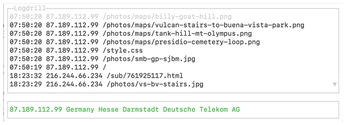Go terminal program geolocates website visitors
Programming Snapshot – Go Geolocation

© Lead Image © bowie15, 123RF.com
Rather than using Google Analytics to geolocate visitors to his website, Mike Schilli uses a simple terminal program in Go for a live-tracking session.
Whether users are browsing through my US blog [1] or finding out about the city hiking trails [2] I've put together in my adopted home of San Francisco, it gives me great pleasure to see how readers navigate the content by tracing the associated web server's logs. In this issue, the terminal UI, Logdrill, grabs one or more access logfiles on the web host, finds which pages have been requested, and displays the latest hits in a continuously scrolling list box. The bottom line of the terminal UI even lists the country of origin of a requesting web client and some of the user's geodata (Figure 1).

A web request's source IP can be used to determine where it came from. Before the web server delivers the requested page, it writes this address – along with the date and path information for the requested page – to the access.log file (Figure 2).
[...]
Buy this article as PDF
(incl. VAT)
